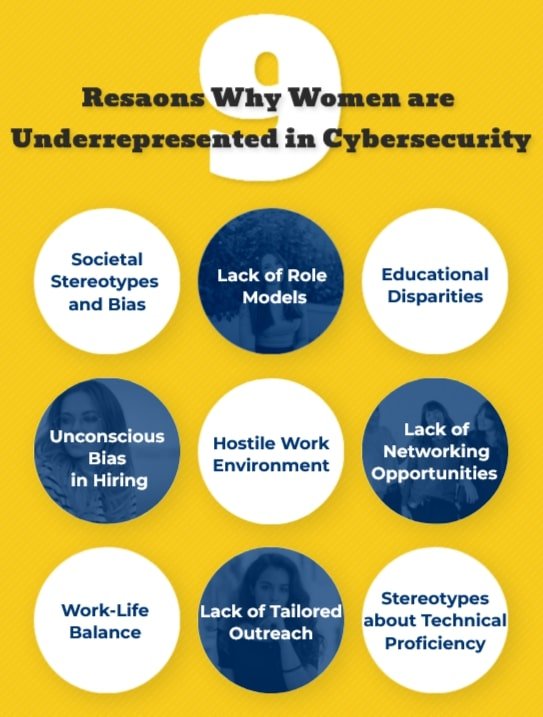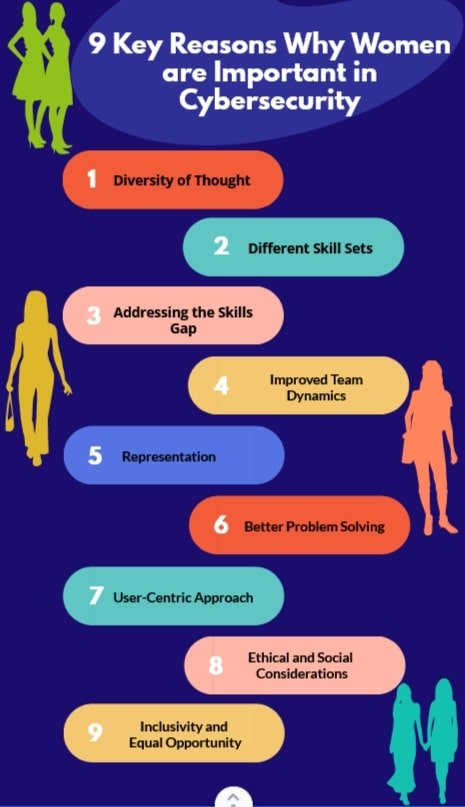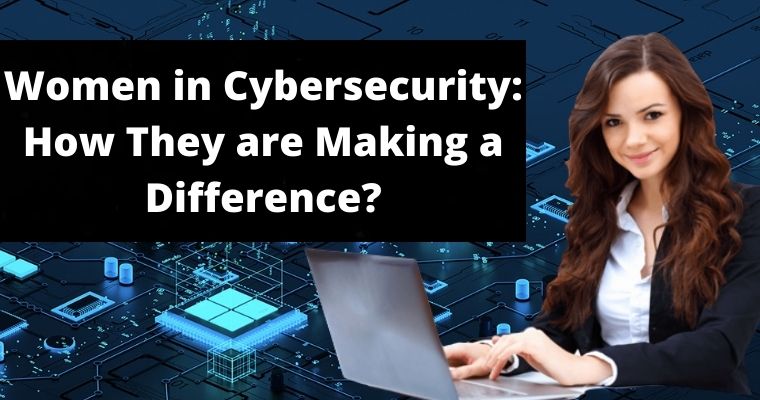According to several reports, the gender gap in tech might not be closing anytime soon. From engineering and IT jobs to cybersecurity positions, there are a lot of men who hold these occupations.
More women than it’s ever been are being promoted to leadership cybersecurity roles, so optimism is the order of the day. Even though the need for unfilled employment openings is driving this shift in mindset, it is a healthy trend for women.
1st September is being celebrated as International Women in Cyber Day to recognize women’s contributions to the field of cybersecurity.
Lynn Dohm from Women in Cybersecurity (WiCyS) highlights the importance of fostering inclusive environments to support women’s success in cybersecurity roles.
Table of Contents
Why are Women Underrepresented in Cybersecurity?
Although women demonstrate exceptional skills and often outperform male colleagues, their representation in cybersecurity remains low, estimated at only 20% to 25%.
The underrepresentation of women in cybersecurity is a complex issue with multiple contributing factors.
The reasons that have historically led to the underrepresentation of women in the cybersecurity field are given below:

Societal Stereotypes and Bias
Societal norms and stereotypes about gender roles can influence career choices for women. Cybersecurity has often been portrayed as a male-dominated field, creating a perception that it may not be welcoming or suitable for females.
Lack of Role Models
The scarcity of visible and prominent female role models in cybersecurity can make it difficult for young women to envision themselves succeeding in the field. Role models play a crucial role in inspiring and motivating individuals to pursue certain careers.
Educational Disparities
There is evidence of gender disparities in STEM education, which is a foundational step towards entering cybersecurity. If girls are discouraged from pursuing science and technology education early on, it can limit their exposure and interest in fields like cybersecurity.
Unconscious Bias in Hiring
Unintentional bias in recruitment and hiring processes can lead to women being overlooked for opportunities. This bias can affect not only initial hiring decisions but also promotions and career advancement.
Hostile Work Environment
Reports of hostile work environments in male-dominated fields can deter women from entering or remaining in cybersecurity. Discrimination, harassment, and lack of inclusivity can contribute to a negative experience.
Lack of Networking Opportunities
Networking is essential for career growth, but if women are underrepresented at industry events, conferences, and networking opportunities, it can limit their access to valuable connections and knowledge.
Work-Life Balance
The perception of long working hours and high-pressure environments in cybersecurity might discourage women, particularly those with caregiving responsibilities, from pursuing careers in the field.
Lack of Tailored Outreach
Educational and professional programs might not always address the unique challenges or interests that women have, further limiting their engagement and interest in cybersecurity.
Stereotypes about Technical Proficiency
There might be lingering stereotypes that women are less technically adept than men, which can impact how their skills and contributions are perceived in technical fields.
Efforts are being made to address these challenges and increase the representation of women in cybersecurity.
It is important to note that the underrepresentation of women in cybersecurity is not due to any inherent lack of ability or interest, but rather a combination of systemic factors that can be changed through proactive efforts and cultural shifts within the industry and society as a whole.
Women frequently encounter a “glass ceiling” within 6 to 10 years of their careers in cybersecurity, limiting their advancement opportunities.
WiCyS 2025 Conference Overview
WiCyS 2025 aims to empower and advance women in cybersecurity through networking, scholarship opportunities, and professional development.
WiCyS 2025 is a leading conference focused on recruiting, retaining, and advancing women in the cybersecurity field.
The in-person conference will take place from April 2-5, 2025, in Dallas, Texas.
Conference Features
- Keynote speeches by prominent figures in cybersecurity.
- Workshops, panels, and hands-on technical presentations.
- Networking opportunities including socials and a career fair to connect employers with professionals and students.
- Additional activities like résumé reviews, mock interviews, and a Capture-the-Flag competition.
Registration Details
- Opens on February 10, 2025, and will remain open until reaching capacity.
- Students require scholarships to attend, with applications opening on September 9, 2024.
Sponsorship Opportunities
Sponsorship for the conference began on August 5, 2024, providing exposure for supporting organizations.
Call for Presenters
Presentations are welcome until November 4, 2024, offering a platform for sharing insights and research.
Scholarship Applications
A variety of scholarships, including for students and military personnel, are available until November 4, 2024.
Virtual Component
A virtual version of the conference is scheduled for April 9-10, 2025, enhancing accessibility with recorded sessions and a virtual career fair.
Historical Success
The previous conference in 2024 hosted over 1,950 attendees with substantial scholarships and sponsorship involvement, showcasing a commitment to inclusivity in cybersecurity.
Women in Cybersecurity: Facts & Figures
Microsoft has partnered with a few organizations focused on skilling women in cybersecurity.
The new partnerships with organizations include WiCyS, Women4Cyber, WOMCY and the International Telecommunications Union.
Australia’s Cybersecurity firm Tesserent says it is committed to filling the gap of women in Cybersecurity as of the 2021 Census women only represented 16% of the Australian cybersecurity workforce.
0xCC in association with Tesserent hosted a Cybersecurity training conference “0xCC 2023” by Women, for Women.
Cybersecurity Talent Crunch says, there is a worldwide talent gap of more than 2 million cybersecurity jobs, with half a million vacancies in North America alone.
The issue is only going to get worse, as demand for cybersecurity resources is forecasted to increase significantly over the next several years.
There are several challenges to overcome with regard to women in computing. One of these difficulties is that the industry could be considerably filled if one part of the population were proportionately represented solely by women.
However, according to Cybercrime Magazine, cybercrime will have an economic cost of $6 trillion each year by 2021, all the way up from $3 trillion in 2015, demonstrating the importance and urgency with which the sector must develop.
According to a study done by Frost and Sullivan in 2013, women make up a mere 11% of the worldwide cybersecurity workforce.
That study, however, was limited in that it only included individuals who still believe that the number of women in cybersecurity (WiCyS) is depressingly low.
According to Cybercrime Magazine’s March 28, 2019 study, women currently account for around 20% of the global infosec payroll. This is, of course, an encouraging development from the previous six years, but it is still far short of 50% equality.
The cybersecurity unemployment rate is now at zero, and it has been for at least three years. So the proportionate difference in employment between women and men cannot be explained by an industry gender bias in hiring.
Why are Women Important in Cybersecurity?
Here are some key reasons why women are crucial in the field of cybersecurity:

Diversity of Thought
Women, with their diverse backgrounds and experiences, can provide unique perspectives and innovative solutions to challenges that may not be considered by a more homogeneous group.
Different Skill Sets
Women possess a wide range of skills that are highly relevant to cybersecurity, including strong communication skills, attention to detail, and analytical thinking.
These skills are crucial for tasks such as threat analysis, risk assessment, and communicating security issues to non-technical stakeholders.
Addressing the Skills Gap
The field of cybersecurity is currently facing a significant skills gap, with a shortage of qualified professionals to fill the growing number of roles.
Encouraging women to enter the field helps address this shortage and brings in a new pool of talent to help defend against cyber threats.
Improved Team Dynamics
Diversity in gender and background leads to better team dynamics. Teams that consist of individuals with different viewpoints tend to make better decisions, as they consider a wider range of possibilities and potential pitfalls.
Representation
Having women in cybersecurity roles serves as role models for younger generations and encourages more women to pursue careers in security and technology sector.
When women see others who look like them succeeding in a field, they are more likely to consider it as a viable career option.
Better Problem Solving
Studies have shown that diverse teams are better at problem-solving and decision-making. Cybersecurity challenges are multifaceted, and having a diverse team can lead to more comprehensive and effective solutions.
User-Centric Approach
Many cybersecurity measures involve designing systems that are secure and user-friendly. Women’s perspectives can contribute to creating security solutions that are not only technically robust but also easy to use and understand.
Ethical and Social Considerations
Cybersecurity issues often intersect with ethics, privacy, and social implications. Woman representation in the field can help ensure that these aspects are thoroughly considered in security strategies and decisions.
Inclusivity and Equal Opportunity
Promoting women’s participation in cybersecurity helps create a more inclusive and equitable industry. It sends a message that the field is open to everyone and that opportunities are not limited by gender.
What is the Percentage of Women in Cybersecurity?
According to reports, the cybersecurity sector currently has a significant gender gap, with only 25% of global cybersecurity jobs held by women in 2022, projected to increase to 35% by 2030.
Various organizations are working exclusively for women to push them into the field of Cybersecurity.
The industry faces an urgent need for 4 million cybersecurity professionals, creating opportunities for women to enter the field.
The study is co-branded with the (ISC)2 Foundation, which is now part of The Center for Cyber Safety and Education and is highly publicized.
Despite a significant increase in the number of women working in cybersecurity, the 11 percent statistic continues to appear in the media due to the lack of new research data from another source, maintaining the stereotype of too few women working in the area.
This was based on in-depth talks with several cybersecurity and human resources professionals, as well as verifying, analyzing, and synthesizing third-party studies, polls, and media sources, as well as compiling our own list.
The 20% ratio is still much too low, and our business must continue to advocate for more women in cyberspace.
However, increased awareness of the issue, driven by various women in cyber organizations and initiatives, has aided in moving the needle in the right direction.
In reality, IT security is a branch of cybersecurity. The cybersecurity Ventures cover IoT security, IIoT, and ICS security, medical device security, automotive cybersecurity, aviation cybersecurity, military cyber defense technologies, and others.
In addition to safeguarding corporate networks (which has witnessed an increase in the number of women).
We also look at the cybersecurity service provider ecosystem, which includes women-owned small companies as well as digital forensics and other positions.
We include Israel, the world’s second-largest exporter of cyber technology (behind the United States), which has a big and rising number of female cybersecurity entrepreneurs and professionals.
What Measures Can be Taken to Increase the Percentage of Women in Cybersecurity?
Strategies for addressing gender inequality in cybersecurity, such as advocating for equal pay, providing mentorship, and encouraging transparency in leadership.

Education and Awareness
Promote STEM education among young girls from an early age to build a strong foundation in technology-related fields.
Raise awareness about the opportunities and benefits of a cybersecurity career through school programs, workshops, seminars, and online resources.
Role Models and Mentoring
Highlight successful women in cybersecurity as role models to inspire and encourage more women to enter the field.
Establish mentoring programs that connect aspiring women in cybersecurity with experienced professionals who can provide guidance and support.
Diverse Work Environment
Create an inclusive and welcoming workplace culture that values diversity and ensures equal opportunities for career growth.
Implement policies that prevent gender bias, discrimination, and harassment.
Recruitment and Hiring
Employ inclusive language in job descriptions to attract a diverse pool of candidates.
Implement blind recruitment practices to minimize unconscious bias during the initial selection process.
Networking and Community Building
Organize meetups, conferences, and networking events specifically focused on women in cybersecurity.
Support and sponsor women’s participation in industry conferences and events.
Education and Training
Collaborate with educational institutions to offer specialized cybersecurity programs that appeal to women and accommodate their needs.
Provide training opportunities, workshops, and certifications to help women enhance their skills and expertise in cybersecurity.
Flexible Work Options
Offer flexible work arrangements such as remote work, flexible hours, and job-sharing to accommodate the diverse needs of women professionals.
Company Leadership Commitment
Have leadership teams committed to diversity and gender equality, setting a strong example for the rest of the organization.
Set specific diversity goals and track progress regularly.
Supportive Policies
Offer family-friendly policies such as parental leave, childcare support, and caregiver assistance to help women balance work and family responsibilities.
Collaboration with Organizations
Collaborate with organizations that promote women in technology, such as Women in Cybersecurity (WiCyS), to leverage their resources and expertise.
Addressing Stereotypes
Challenge and counteract stereotypes about gender roles in technology through educational campaigns and discussions.
Showcasing Success Stories
Share success stories of women who have excelled in cybersecurity to demonstrate the range of opportunities available in the field.
Remember that creating a diverse and inclusive environment requires ongoing effort and commitment.
By implementing a combination of these strategies, the percentage of women in cybersecurity can be increased, leading to a more vibrant and innovative industry.
Women in Cybersecurity Field: Statistics
Despite the fact that males outnumber women three to one in cybersecurity, more women are entering the sector – and they’re aiming for leadership roles.
Women in cybersecurity are establishing themselves in the field, aided by greater educational attainment and certifications than their men equivalents.
According to the 2018 (ISC)2 Workforce Study, women are more likely than men to reach leadership roles such as chief technology officer (7 percent vs. 2 percent), vice president of IT (9 percent vs. 5 percent), IT director (18 percent vs. 14 percent), and C-level/ executive (28 percent vs. 19 percent).
Women are establishing a route to management, according to the data. They are better educated and younger in general.
While 44 percent of males in the cybersecurity field have a post-graduate degree, just 52 percent of women have.
Nearly half of the women questioned in the cybersecurity field are millennials, with 45 percent compared to 33 percent of males.
Men from Generation X, on the other hand, make up a larger share of the workforce (44%) than women (25 percent ).
According to the report, women make up approximately a quarter of the cybersecurity workforce (24 percent).
This is a substantial increase from 2017 when only 11 percent of research participants were female. It’s worth noting that this study employed a new research approach.
As a result, women are more likely to be represented.
Women make up a considerably larger percentage of Australia’s cybersecurity workforce than the reported global number of 11%.
According to the 2018 McAfee Cybersecurity Talent Study, Australia’s cybersecurity workforce is 25% women.
According to research performed by BeecherMadden, a prominent, award-winning U.K. and U.S. cybersecurity recruitment firm, the U.K. cybersecurity sector is currently 18 percent female.
Karla Reffold, COO and founder of BeecherMadden, says, “Given that expanding the number of women in cybersecurity is a goal that many firms have, we should all be delighted that we have begun making progress.”
“18 percent is still not enough, and while 50 percent may seem far away, other firms are already at this level.”
Women in Cybersecurity: Pay isn’t the same for Female Cyber Experts
Women in cybersecurity, according to our research, still have a long way to go in several areas, particularly pay.
Women believed they made between $50,000 and $99,999 (29 percent vs. 39 percent of males), a whole 12 percentage points less than males.
Women are slightly more prevalent in the $100,000+ category Age and tenure may contribute to some of the differences.
Women cybersecurity experts are sometimes younger than their male counterparts, which might explain part of the gap.
The higher education gap may be due to a variety of reasons, and it’s possible that the disparity in degrees and certificates is one of them. Women are more sensitive than men when it comes to aesthetics.
Males (28%) outnumber females (20%) in cybersecurity-related bachelor’s degrees and other related college graduate programs.
According to the Cybersecurity Workforce Study, there are a lot of people interested in working in cybersecurity. On average, women earn more cybersecurity certifications than males.
Cybersecurity specialists may be establishing a path to career development and acquiring the skills to take on greater responsibility by focusing more on education and certification.
With this job of leadership, you earn more responsibility and reputation among coworkers, as well as a raise in pay.
The findings of our analysis suggest that as women continue to face difficulties, such as wage disparity, their efforts are paying off.
Women are more likely to hold managerial responsibilities and are higher in the corporate hierarchy than men.
For instance, 11% of women report to the vice president of IT, whereas 6% of males do, while 19% report to the IT security director, compared with 14% of males.
These advances are essential not just for today’s women in cybersecurity, but also for future generations. The more females who succeed in cybersecurity, the more likely it is that others will do so as well.
This would fill a current need since there are currently almost 3 million worldwide cybersecurity skills shortages. Younger women experience less significant salary disparities than older women across the world.
In terms of pay, in relation to their adult male peers, 21% of Millennial women make $50,000 to $99,999, whereas 29% of men do.
In contrast, 10% of female Baby Boomers earn as much as 30% of male Baby Boomers, in comparison.
In comparison to their male counterparts of the same age, there was a 12% gap in the number of Generation X women making $50,000 to $99,999, as well as a 12% difference in the number of Baby Boomer women earning more than $100,000.
The 3% income gap between Millennial women and males.
How Can We have more Women in the Field of Cybersecurity?
What steps are being taken to entice more women into the cybersecurity profession in light of this harsh reality? What additional efforts or changes may be made to improve the process and behavioral flaws, as well?
Much has already been achieved, with varying degrees of success that are beginning to move the needle. If the personnel shortage in cybersecurity is to be addressed effectively,
To begin, create a diversity policy at work that includes persons of all nationalities and cultures. Helpnetsecurity.com published an article in 2017 titled “What attracts women to cybersecurity, and what keeps them there?”
According to the survey conducted by Cobalt, an app security firm, a team with a variety of all sorts – disciplines, genders, backgrounds, races, etc. – provides fresh viewpoints that stimulate innovation and creativity. “
The goal of this website is to provide information about females and the internet. Cybersecurity is an important topic for girls, and we want to help them learn more about it!
For years, young women have been underrepresented in technology sectors and face challenges such as low pay rates and a dearth of female role models. As a result of these factors
The objective of Girls Who Code is to fill the gender gap in technological occupations in general, not just to appeal to young students interested in programming as a career path.
After-school programs, summer classes, and summer immersion programs are all promoted by the organization. It also helps program graduates get into college and meet other women working in technical industries after they
To encourage young girls to learn about cybersecurity and succeed at it, the Girl Scouts of the United States has created a cyber merit badge.
In 2019, the Girl Scouts Research Institute published “Decoding the Digital Girl: Measuring and Promoting Girls’ Digital Statesmanship,” a study. It claims that how ladies are using their digital experiences
Priorities & Some Concerns
Women and men cybersecurity employees share many priorities in performing their job duties, according to earlier (ISC)2 research.
They share many of the common same concerns in this field, say
- Such as a lack of commitment from upper management,
- Their organization’s reputation, the risk of their job being outsourced, a lack of work/life balance,
- The threat of artificial intelligence (AI) reducing the need for cybersecurity workers,
- Finally, a lack of standardized cybersecurity terminology to communicate within their organizations effectively.
In these fields, the gender divide is seldom as significant as it is in other areas. For example, the difference in anxiety about employers not listening to their ideas is merely 2%. (16 percent of women vs. 18 percent of men).
When it comes to being concerned about a lack of work-life balance, the difference is only 2% (28 percent of women vs. 26 percent of males).
Scholarships and Financial Assistance for Women Who Pursue Cyber Security as a Career Option
Women who want to work in cybersecurity or other STEM areas are receiving more financial and non-financial assistance.
Information security scholarships are also available for community college and professional training.
Women interested in cybersecurity careers may apply for scholarships from InfoSec, Inc. and CompTIA that include free attendance at cybersecurity boot camps.
The United States Navy’s Information Assurance Scholarship Program is a scholarship-for-service program open to both men and women.
In collaboration with (ISC)2, the Center for Cyber Safety and Education awards a $40,000 scholarship to females pursuing a bachelor’s or master’s degree in cybersecurity.
SWSIS is an education program sponsored by Applied Computer Security Associates (ACSA) and CRA-WP that aims to improve women’s computer security skills.
Raytheon gives out an $8,000 scholarship to female cybersecurity students.
The National Security Agency sponsors the Scopes Educational Scholarship Program for high school seniors who have demonstrated competence in key components of computer science and electrical engineering and plan to specialize in one of them, such as cybersecurity.
In addition to summer employment, the CIA offers several internship programs!



